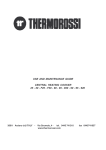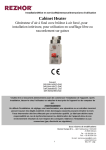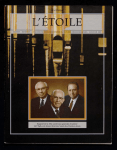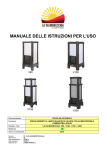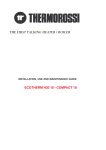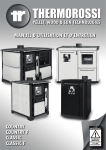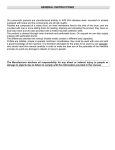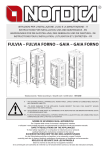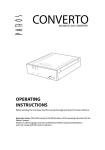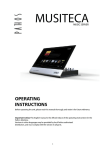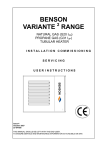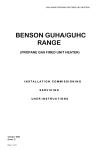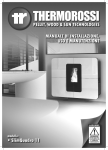Download BOSKY ING - Harworth Heating Ltd
Transcript
THERMOROSSI BOSKY 25,30 & F25, F30 COUNTRY, COUNTRY F INSTALLATION, USER & SERVICE MANUAL VER 1 10/2015 THERMOROSSI UK, BLYTH ROAD, HARWORTH, DONCASTER UK DN11 8NE tel. (0044) 1302742520 fax 01302 750573 EMAIL - [email protected] www.thermorossi.co.uk 1. 1.1 1.2 1.3 1.4 2. 3. 4. 4.1 4.2 5. 5.1 5.2 5.3 5.4 5.5 5.6 5.7 5.8 5.9 6. 6.1 6.2 6.3 6.4 6.5 6.6 7. 7.1 7.2 7.3 8. 8.1 CONTENTS DECLARATION OF CONFORMITY INTRODUCTION ..................................................................................................... General guidelines..................................................................................................... Safety guidelines ......................................................................................................... Standards and recommendations ............................................................................... Transport and storage .......................................................................................... TECHNICAL CHARACTERISTICS ............................................................................. Vitrification..................................................................................................................... GENERAL DESCRIPTION.......................................................................................... Operating principle ..................................................................................................... Wood fuel..................................................................................................................... INSTALLATION .......................................................................................................... Locating your Bosky central heating cooker. .............................................................. Installing the safety heat exchanger (only for 25 - 30 - F25 - F30 ) ....................... Wiring diagram 25 - 30. ................................................................................... Wiring diagram F25 - F30. ........................................................................................ ...................................................................................................................................... Guidelines for the hydraulic connections of the central heating cooker to the boiler coil….............. Guidelines for the hydraulic connections of the central heating cooker to the boiler tubes with interspacing ................... Recommendations for the execution of the hydraulic and electric system ...................................... Installation of casing for Bosky 25-30-F25-F30. .................................................. OPERATION ............................................................................................................... Description of parts and main controls of the central heating cookers ............................................ Lighting and starting the central heating cookers ................................................ Operation of the central heating cookers ..................................................................... Grate positions in the central heating cookers .................................................... How to use the oven in central heating cookers F25-F30............................................. The fold-away towel rack (only for 25 - 30 - F25 - F30 ) ............................................. CLEANING AND MAINTENANCE ............................................................................... General cleaning.......................................................................................................... Ash .............................................................................................................................. How to clean the hot plate .......................................................................................... 6.4 How to replace the oven light bulb .............................................................. 6.5 Recommendations ................................................................................... FLUE ...................................................................................... General. ....................................................................................................................... 8.2 8.3 8.4 9. 10. 11. Essential requirements for the chimney cap ........................................................... Ventilation of the rooms ......................................................................................... Connection with the flue outlet...................................................................................... TROUBLESHOOTING ................................................................................................. Problems, causes and remedies for Bosky central heating cookers .............................................. SPARE PARTS ........................................................................................................... DICHIARAZIONE DI CONFORMITA ' DECLARATION OF CONFORMITY La THERMOROSSI S.P.A., VIA GRUMOLO N° 4 36011 ARSIERO (VI), sotto la sua esclusiva responsabilità DICHIARA che l’apparecchiatura descritta in appresso: DECLARES that the product: Descrizione Description Cucina a legna Wood Cooker Marchio Trademark THERMOROSSI S.P.A. Modelli Models BOSKY COUNTRY BOSKY COUNTRY – F BOSKY 25 BOSKY F25 BOSKY 30 BOSKY F30 è conforme alle disposizioni legislative che traspongono le seguenti Direttive: • 2004/108/CE (Direttiva EMC) • 2006/95/CE (Direttiva Bassa tensione) • • 2011/65/EU (Direttiva RoHS 2) is in accordance with the following Directives: • 2004/108/EC Directive (EMC Directive) • 2006/95/EC Directive (Low Voltage Directive) • • 2011/65/EU Directive (RoHS 2) e che sono state applicate tutte le norme e/o specifiche tecniche di seguito indicate and that all the following standards have been applied EN 55014-1 EN 55014-2 EN 61000-3-2 EN 61000-3-3 EN 60335-1 EN 60335-2-102 EN 62233 Ultime due cifre dell’anno in cui è affissa la marcatura CE Last two figures of the year of the CE marking Luogo Place Data Date Firma Sign Arsiero EN 50581 11 DICHIARAZIONE DI PRESTAZIONE DECLARATION OF PERFORMANCE 1/2 Dichiarazione di prestazione in accordo con il Regolamento (UE) 305/2011 Declaration of performance according to Regulation (EU) 305/2011 N° 20 Unique identification code of the product type: 1 BOSKY 25, apparecchio per il riscaldamento domestico, con acqua, alimentato a ceppi di legna BOSKY 25, residential space heating appliance with water fired by wood logs EN 12815:2001 A1:2004 Numero di tipo, lotto , serie o qualsiasi altro elemento che consenta l'identificazione del prodotto da costruzione ai sensi dell'articolo 11, paragrafo 4: 2 Type, batch or serial number or any other element allowing identification of the construction product as required under Article 11( 4): BOSKY 25 Uso o usi previsti del prodotto da costruzione, conformemente alla relativa specifica tecnica armonizzata, come previsto dal fabbricante: Intended use or uses of the construction product, in accordance with the applicable harmonised 3 technical specification, as foreseen by the manufacturer: Apparecchio per il riscaldamento domestico, con acqua, alimentato a ceppi di legna Residential space heating appliance with water fired by wood logs Nome, denominazione commerciale registrata o marchio registrato e indirizzo del fabbricante ai sensi dell'articolo 11, paragrafo 5: 4 Name, registered trade name or registered trade mark and contact address of the manufacturer as required pursuant Article 11( 5): THERMOROSSI S.P.A. Via Grumolo, n° 4 36011 Arsiero (VI) Sistema o sistemi di valutazione e verifica della costanza della prestazione del prodotto da costruzione di cui all'allegato V: 5 System or systems of assessment and verification of constancy of performance of the construction product as set out in Annex V: Sistema 3 e 4 / System 3and 4 Nel caso di una dichiarazione di prestazione relativa ad un prodotto da costruzione che rientra nell'ambito di applicazione di una norma armonizzata: In case of the declaration of performance concerning a construction product covered by a harmonised standard: 6 L' organismo notificato KIWA ITALIA S.P.A. N° 0694 ha determinato il prodotto-tipo in base a prove di tipo secondo il sistema 3 ed ha rilasciato il rapporto di prova 400238 The notified laboratory KIWA ITALIA S.P.A. N° 0694 performed the determination of the product type on the basis of type testing under system 3 and issued test report 400238 7 La prestazione del prodotto di cui ai punti 1 e 2 è conforme alla prestazione dichiarata di cui al punto 7. Si rilascia la presente dichiarazione di prestazione sotto la responsabilità esclusiva del fabbricante di cui al punto 4 8 The performance of the product identified in points 1 and 2 is in conformity with the declared performance in point 7. This declaration of performance is issued under the sole responsibility of the manufacturer identified in point 4 Firmato a nome e per conto del fabbricante da (nome e funzione) Signed for and on behalf of the manufacturer (name and title) Luogo/Place Arsiero Data/Date27/06/2013 Specifica tecnica armonizzata: Harmonized technical specification: EN 12815:2001 A1:2004 Caratteristiche Essenziali Essential characteristics Prestazione / Performance Sicurezza antincendio / Fire safety Reazione al fuoco / Reaction to fire A1 Distanza da materiali combustibili Distance to combustible materials Minime distanze / Minimum distances (mm): posteriore / rear = 200 lati / sides = 200 frontale / front = 800 soffitto / ceiling = - pavimento / floor = - Rischio di fuoriuscita di braci incandescenti Risk of burning fuel falling out Passa / Pass Emissione di prodotti della combustione Emission of combustion products CO 4692 ppm Alla potenza termica nominale / Nominal heat output Temperatura superficiale / Surface temperature Passa / Pass Sicurezza elettrica / Electrical safety - Pulizia / Cleanability Passa / Pass Pressione massima di esercizio Maximum operating pressure 3 bar Temperatura fumi a potenza termica nominale Flue gas temperature at nominal heat output T287 °C Resistenza meccanica (per sopportare un camino/una canna fumaria) Mechanical resistance(to carry a chimney/flue) NPD {Nessuna Prestazione Determinata} Potenza termica nominale / Nominal heat output 21,00 kW Potenza termica resa in ambiente / Room heating output 3,00 kW Potenza termica ceduta all’acqua / Water heating output 18,00 kW Rendimento Efficiency 71,00 % Alla potenza termica nominale / Nominal heat output DICHIARAZIONE DI PRESTAZIONE DECLARATION OF PERFORMANCE 1/2 Dichiarazione di prestazione in accordo con il Regolamento (UE) 305/2011 Declaration of performance according to Regulation (EU) 305/2011 N° 20B 1 2 3 Codice di identificazione unico del prodotto-tipo: Unique identification code of the product type: BOSKY F25, apparecchio per il riscaldamento domestico, con acqua, alimentato a ceppi di legna BOSKY F25, residential space heating appliance with water fired by wood logs EN 12815:2001 A1:2004 Numero di tipo, lotto , serie o qualsiasi altro elemento che consenta l'identificazione del prodotto da costruzione ai sensi dell'articolo 11, paragrafo 4: Type, batch or serial number or any other element allowing identification of the construction product as required under Article 11( 4): BOSKY F25 Uso o usi previsti del prodotto da costruzione, conformemente alla relativa specifica tecnica armonizzata, come previsto dal fabbricante: Intended use or uses of the construction product, in accordance with the applicable harmonised technical specification, as foreseen by the manufacturer: Apparecchio per il riscaldamento domestico, con acqua, alimentato a ceppi di legna Residential space heating appliance with water fired by wood logs 4 Nome, denominazione commerciale registrata o marchio registrato e indirizzo del fabbricante ai sensi dell'articolo 11, paragrafo 5: Name, registered trade name or registered trade mark and contact address of the manufacturer as required pursuant Article 11( 5): THERMOROSSI S.P.A. Via Grumolo, n° 4 36011 Arsiero (VI) 5 Sistema o sistemi di valutazione e verifica della costanza della prestazione del prodotto da costruzione di cui all'allegato V: System or systems of assessment and verification of constancy of performance of the construction product as set out in Annex V: Sistema 3 e 4 / System 3and 4 Nel caso di una dichiarazione di prestazione relativa ad un prodotto da costruzione che rientra nell'ambito di applicazione di una norma armonizzata: In case of the declaration of performance concerning a construction product covered by a harmonised standard: 6 L' organismo notificato KIWA ITALIA S.P.A. N° 0694 ha determinato il prodottotipo in base a prove di tipo secondo il sistema 3 ed ha rilasciato il rapporto di prova 400238 The notified laboratory KIWA ITALIA S.P.A. N° 0694 performed the determination of the product type on the basis of type testing under system 3 and issued test report 400238 7 La prestazione del prodotto di cui ai punti 1 e 2 è conforme alla prestazione dichiarata di cui al punto 7. Si rilascia la presente dichiarazione di prestazione sotto la responsabilità esclusiva del fabbricante di cui al punto 4 8 The performance of the product identified in points 1 and 2 is in conformity with the declared performance in point 7. This declaration of performance is issued under the sole responsibility of the manufacturer identified in point 4 Specifica tecnica armonizzata: Harmonized technical specification: EN 12815:2001 A1:2004 Caratteristiche Essenziali Essential characteristics Prestazione / Performance Sicurezza antincendio / Fire safety Reazione al fuoco / Reaction to fire A1 Distanza da materiali combustibili Distance to combustible materials Minime distanze / Minimum distances (mm): posteriore / rear = 200 lati / sides = 200 frontale / front = 800 soffitto / ceiling = - pavimento / floor = - Rischio di fuoriuscita di braci incandescenti Risk of burning fuel falling out Passa / Pass Emissione di prodotti della combustione Emission of combustion products CO 4692 ppm Alla potenza termica nominale / Nominal heat output Temperatura superficiale / Surface temperature Passa / Pass Sicurezza elettrica / Electrical safety - Pulizia / Cleanability Passa / Pass Pressione massima di esercizio Maximum operating pressure 3 bar Temperatura fumi a potenza termica nominale Flue gas temperature at nominal heat output T287 °C Resistenza meccanica (per sopportare un camino/una canna fumaria) Mechanical resistance(to carry a chimney/flue) NPD {Nessuna Prestazione Determinata} Potenza termica nominale / Nominal heat output 21,00 kW Potenza termica resa in ambiente / Room heating output 3,00 kW Potenza termica ceduta all’acqua / Water heating output 18,00 kW Rendimento Efficiency 71,00 % Alla potenza termica nominale / Nominal heat output DICHIARAZIONE DI PRESTAZIONE DECLARATION OF PERFORMANCE 1/2 Dichiarazione di prestazione in accordo con il Regolamento (UE) 305/2011 Declaration of performance according to Regulation (EU) 305/2011 N° 20C Codice di identificazione unico del prodotto-tipo: Unique identification code of the product type: 1 BOSKY 30, apparecchio per il riscaldamento domestico, con acqua, alimentato a ceppi di legna BOSKY 30, residential space heating appliance with water fired by wood logs EN 12815:2001 A1:2004 Numero di tipo, lotto , serie o qualsiasi altro elemento che consenta l'identificazione del prodotto da costruzione ai sensi dell'articolo 11, paragrafo 4: 2 Type, batch or serial number or any other element allowing identification of the construction product as required under Article 11( 4): BOSKY 30 Uso o usi previsti del prodotto da costruzione, conformemente alla relativa specifica tecnica armonizzata, come previsto dal fabbricante: Intended use or uses of the construction product, in accordance with the applicable harmonised 3 technical specification, as foreseen by the manufacturer: Apparecchio per il riscaldamento domestico, con acqua, alimentato a ceppi di legna Residential space heating appliance with water fired by wood logs Nome, denominazione commerciale registrata o marchio registrato e indirizzo del fabbricante ai sensi dell'articolo 11, paragrafo 5: 4 Name, registered trade name or registered trade mark and contact address of the manufacturer as required pursuant Article 11( 5): THERMOROSSI S.P.A. Via Grumolo, n° 4 36011 Arsiero (VI) Sistema o sistemi di valutazione e verifica della costanza della prestazione del prodotto da costruzione di cui all'allegato V: 5 System or systems of assessment and verification of constancy of performance of the construction product as set out in Annex V: Sistema 3 e 4 / System 3and 4 Nel caso di una dichiarazione di prestazione relativa ad un prodotto da costruzione che rientra nell'ambito di applicazione di una norma armonizzata: In case of the declaration of performance concerning a construction product covered by a harmonised standard: 6 L' organismo notificato KIWA ITALIA S.P.A. N° 0694 ha determinato il prodottotipo in base a prove di tipo secondo il sistema 3 ed ha rilasciato il rapporto di prova 400238 The notified laboratory KIWA ITALIA S.P.A. N° 0694 performed the determination of the product type on the basis of type testing under system 3 and issued test report 400238 La prestazione del prodotto di cui ai punti 1 e 2 è conforme alla prestazione dichiarata di cui al punto 7. Si rilascia la presente dichiarazione di prestazione sotto la responsabilità esclusiva del fabbricante di cui al punto 4 The performance of the product identified in points 1 and 2 is in conformity with the declared performance in point 7. This declaration of performance is issued under the sole responsibility of the manufacturer identified in point 4 Firmato a nome e per conto del fabbricante da (nome e funzione) Signed for and on behalf of the manufacturer (name and title) Luogo/Place Data/Date Arsiero 27/06/2013 Specifica tecnica armonizzata: Harmonized technical specification: EN 12815:2001 A1:2004 Caratteristiche Essenziali Essential characteristics Prestazione / Performance Sicurezza antincendio / Fire safety Reazione al fuoco / Reaction to fire A1 Distanza da materiali combustibili Distance to combustible materials Minime distanze / Minimum distances (mm): posteriore / rear = 200 lati / sides = 200 frontale / front = 800 soffitto / ceiling = - pavimento / floor = - Rischio di fuoriuscita di braci incandescenti Risk of burning fuel falling out Passa / Pass Emissione di prodotti della combustione Emission of combustion products CO 4630 ppm Alla potenza termica nominale / Nominal heat output Temperatura superficiale / Surface temperature Passa / Pass Sicurezza elettrica / Electrical safety - Pulizia / Cleanability Passa / Pass Pressione massima di esercizio Maximum operating pressure 3 bar Temperatura fumi a potenza termica nominale Flue gas temperature at nominal heat output T360 °C Resistenza meccanica (per sopportare un camino/una canna fumaria) Mechanical resistance(to carry a chimney/flue) NPD {Nessuna Prestazione Determinata} Potenza termica nominale / Nominal heat output 21,40 kW Potenza termica resa in ambiente / Room heating output 2,30 kW Potenza termica ceduta all’acqua / Water heating output 19,10 kW Rendimento Efficiency 70,10 % Alla potenza termica nominale / Nominal heat output DICHIARAZIONE DI PRESTAZIONE DECLARATION OF PERFORMANCE 1/2 Dichiarazione di prestazione in accordo con il Regolamento (UE) 305/2011 Declaration of performance according to Regulation (EU) 305/2011 N° 20D Codice di identificazione unico del prodotto-tipo: Unique identification code of the product type: BOSKY F30, apparecchio per il riscaldamento domestico, con acqua, alimentato a ceppi di 1 legna BOSKY F30, residential space heating appliance with water fired by wood logs EN 12815:2001 A1:2004 Numero di tipo, lotto , serie o qualsiasi altro elemento che consenta l'identificazione del prodotto da costruzione ai sensi dell'articolo 11, paragrafo 4: 2 Type, batch or serial number or any other element allowing identification of the construction product as required under Article 11( 4): BOSKY F30 Uso o usi previsti del prodotto da costruzione, conformemente alla relativa specifica tecnica armonizzata, come previsto dal fabbricante: Intended use or uses of the construction product, in accordance with the applicable harmonised 3 technical specification, as foreseen by the manufacturer: Apparecchio per il riscaldamento domestico, con acqua, alimentato a ceppi di legna Residential space heating appliance with water fired by wood logs Nome, denominazione commerciale registrata o marchio registrato e indirizzo del fabbricante ai sensi dell'articolo 11, paragrafo 5: 4 Name, registered trade name or registered trade mark and contact address of the manufacturer as required pursuant Article 11( 5): THERMOROSSI S.P.A. Via Grumolo, n° 4 36011 Arsiero (VI) Sistema o sistemi di valutazione e verifica della costanza della prestazione del prodotto da costruzione di cui all'allegato V: 5 System or systems of assessment and verification of constancy of performance of the construction product as set out in Annex V: Sistema 3 e 4 / System 3and 4 Nel caso di una dichiarazione di prestazione relativa ad un prodotto da costruzione che rientra nell'ambito di applicazione di una norma armonizzata: In case of the declaration of performance concerning a construction product covered by a harmonised standard: 6 L' organismo notificato KIWA ITALIA S.P.A. N° 0694 ha determinato il prodottotipo in base a prove di tipo secondo il sistema 3 ed ha rilasciato il rapporto di prova 400238 The notified laboratory KIWA ITALIA S.P.A. N° 0694 performed the determination of the product type on the basis of type testing under system 3 and issued test report 400238 La prestazione del prodotto di cui ai punti 1 e 2 è conforme alla prestazione dichiarata di cui al punto 7. Si rilascia la presente dichiarazione di prestazione sotto la responsabilità esclusiva del fabbricante di cui al punto 4 The performance of the product identified in points 1 and 2 is in conformity with the declared performance in point 7. This declaration of performance is issued under the sole responsibility of the manufacturer identified in point 4 Firmato a nome e per conto del fabbricante da (nome e funzione) Signed for and on behalf of the manufacturer (name and title) Luogo/Place Data/Date Arsiero 27/06/2013 Specifica tecnica armonizzata: Harmonized technical specification: EN 12815:2001 A1:2004 Caratteristiche Essenziali Essential characteristics Prestazione / Performance Sicurezza antincendio / Fire safety Reazione al fuoco / Reaction to fire A1 Distanza da materiali combustibili Distance to combustible materials Minime distanze / Minimum distances (mm): posteriore / rear = 200 lati / sides = 200 frontale / front = 800 soffitto / ceiling = - pavimento / floor = - Rischio di fuoriuscita di braci incandescenti Risk of burning fuel falling out Passa / Pass Emissione di prodotti della combustione Emission of combustion products CO 4630 ppm Alla potenza termica nominale / Nominal heat output Temperatura superficiale / Surface temperature Passa / Pass Sicurezza elettrica / Electrical safety - Pulizia / Cleanability Passa / Pass Pressione massima di esercizio Maximum operating pressure 3 bar Temperatura fumi a potenza termica nominale Flue gas temperature at nominal heat output T360 °C Resistenza meccanica (per sopportare un camino/una canna fumaria) Mechanical resistance(to carry a chimney/flue) NPD {Nessuna Prestazione Determinata} Potenza termica nominale / Nominal heat output 21,40 kW Potenza termica resa in ambiente / Room heating output 2,30 kW Potenza termica ceduta all’acqua / Water heating output 19,10 kW Rendimento Efficiency 70,10 % Alla potenza termica nominale / Nominal heat output DICHIARAZIONE DI PRESTAZIONE DECLARATION OF PERFORMANCE 1/2 Dichiarazione di prestazione in accordo con il Regolamento (UE) 305/2011 Declaration of performance according to Regulation (EU) 305/2011 N° 27 1 2 3 4 5 Codice di identificazione unico del prodotto-tipo: Unique identification code of the product type: BOSKY COUNTRY, apparecchio per il riscaldamento domestico, con acqua, alimentato a ceppi di legna BOSKY COUNTRY, residential space heating appliance with water fired by wood logs EN 12815:2001 A1:2004 Numero di tipo, lotto , serie o qualsiasi altro elemento che consenta l'identificazione del prodotto da costruzione ai sensi dell'articolo 11, paragrafo 4: Type, batch or serial number or any other element allowing identification of the construction product as required under Article 11( 4): BOSKY COUNTRY Uso o usi previsti del prodotto da costruzione, conformemente alla relativa specifica tecnica armonizzata, come previsto dal fabbricante: Intended use or uses of the construction product, in accordance with the applicable harmonised technical specification, as foreseen by the manufacturer: Apparecchio per il riscaldamento domestico, con acqua, alimentato a ceppi di legna Residential space heating appliance with water fired by wood logs Nome, denominazione commerciale registrata o marchio registrato e indirizzo del fabbricante ai sensi dell'articolo 11, paragrafo 5: Name, registered trade name or registered trade mark and contact address of the manufacturer as required pursuant Article 11( 5): THERMOROSSI S.P.A. Via Grumolo, n° 4 36011 Arsiero (VI) Sistema o sistemi di valutazione e verifica della costanza della prestazione del prodotto da costruzione di cui all'allegato V: System or systems of assessment and verification of constancy of performance of the construction product as set out in Annex V: Sistema 3 e 4 / System 3and 4 Nel caso di una dichiarazione di prestazione relativa ad un prodotto da costruzione che rientra nell'ambito di applicazione di una norma armonizzata: In case of the declaration of performance concerning a construction product covered by a harmonised standard: 6 La prestazione del prodotto di cui ai punti 1 e 2 è conforme alla prestazione dichiarata di cui al punto 7. Si rilascia la presente dichiarazione di prestazione sotto la responsabilità esclusiva del fabbricante di cui al punto 4 7 The performance of the product identified in points 1 and 2 is in conformity with the declared performance in point 7. This declaration of performance is issued under the sole responsibilityof the manufacturer identified in point 4 Firmato a nome e per conto del fabbricante da (nome e funzione) Signed for and on behalf of the manufacturer (name and title) Luogo/Place Data/Date 8 Arsiero 27/06/2013 Specifica tecnica armonizzata: Harmonized technical specification: EN 12815:2001 A1:2004 Caratteristiche Essenziali Essential characteristics Prestazione / Performance Sicurezza antincendio / Fire safety Reazione al fuoco / Reaction to fire A1 Distanza da materiali combustibili Distance to combustible materials Minime distanze / Minimum distances (mm): posteriore / rear = 200 lati / sides = 200 frontale / front = 800 soffitto / ceiling = - pavimento / floor = - Rischio di fuoriuscita di braci incandescenti Risk of burning fuel falling out Passa / Pass Emissione di prodotti della combustione Emission of combustion products CO 4630 ppm Alla potenza termica nominale / Nominal heat output Temperatura superficiale / Surface temperature Passa / Pass Sicurezza elettrica / Electrical safety - Pulizia / Cleanability Passa / Pass Pressione massima di esercizio Maximum operating pressure 3 bar Temperatura fumi a potenza termica nominale Flue gas temperature at nominal heat output T360 °C Resistenza meccanica (per sopportare un camino/una canna fumaria) Mechanical resistance(to carry a chimney/flue) NPD {Nessuna Prestazione Determinata} Potenza termica nominale / Nominal heat output 21,40 kW Potenza termica resa in ambiente / Room heating output 2,30 kW Potenza termica ceduta all’acqua / Water heating output 19,10 kW Rendimento Efficiency 70,10 % Alla potenza termica nominale / Nominal heat output DICHIARAZIONE DI PRESTAZIONE DECLARATION OF PERFORMANCE 1/2 Dichiarazione di prestazione in accordo con il Regolamento (UE) 305/2011 Declaration of performance according to Regulation (EU) 305/2011 N° 27B Codice di identificazione unico del prodotto-tipo: Unique identification code of the product type: BOSKY COUNTRY - F, apparecchio per il riscaldamento domestico, con acqua, alimentato a 1 ceppi di legna BOSKY COUNTRY - F, residential space heating appliance with water fired by wood logs EN 12815:2001 A1:2004 Numero di tipo, lotto , serie o qualsiasi altro elemento che consenta l'identificazione del prodotto da costruzione ai sensi dell'articolo 11, paragrafo 4: 2 Type, batch or serial number or any other element allowing identification of the construction product as required under Article 11( 4): BOSKY COUNTRY - F Uso o usi previsti del prodotto da costruzione, conformemente alla relativa specifica tecnica armonizzata, come previsto dal fabbricante: Intended use or uses of the construction product, in accordance with the applicable harmonised 3 technical specification, as foreseen by the manufacturer: Apparecchio per il riscaldamento domestico, con acqua, alimentato a ceppi di legna Residential space heating appliance with water fired by wood logs Nome, denominazione commerciale registrata o marchio registrato e indirizzo del fabbricante ai sensi dell'articolo 11, paragrafo 5: 4 Name, registered trade name or registered trade mark and contact address of the manufacturer as required pursuant Article 11( 5): THERMOROSSI S.P.A. Via Grumolo, n° 4 36011 Arsiero (VI) Sistema o sistemi di valutazione e verifica della costanza della prestazione del prodotto da costruzione di cui all'allegato V: 5 System or systems of assessment and verification of constancy of performance of the construction product as set out in Annex V: Sistema 3 e 4 / System 3and 4 Nel caso di una dichiarazione di prestazione relativa ad un prodotto da costruzione che rientra nell'ambito di applicazione di una norma armonizzata: In case of the declaration of performance concerning a construction product covered by a harmonised standard: The performance of the product identified in points 1 and 2 is in conformity with the declared performance in point 7. This declaration of performance is issued under the sole responsibility of the manufacturer identified in point 4 Firmato a nome e per conto del fabbricante da (nome e funzione) Signed for and on behalf of the manufacturer (name and title) Luogo/Place Arsiero Data/Date 27/06/2013 Specifica tecnica armonizzata: Harmonized technical specification: EN 12815:2001 A1:2004 Caratteristiche Essenziali Essential characteristics Prestazione / Performance Sicurezza antincendio / Fire safety Reazione al fuoco / Reaction to fire A1 Distanza da materiali combustibili Distance to combustible materials Minime distanze / Minimum distances (mm): posteriore / rear = 200 lati / sides = 200 frontale / front = 800 soffitto / ceiling = - pavimento / floor = - Rischio di fuoriuscita di braci incandescenti Risk of burning fuel falling out Passa / Pass Emissione di prodotti della combustione Emission of combustion products CO 4630 ppm Alla potenza termica nominale / Nominal heat output Temperatura superficiale / Surface temperature Passa / Pass Sicurezza elettrica / Electrical safety - Pulizia / Cleanability Passa / Pass Pressione massima di esercizio Maximum operating pressure 3 bar Temperatura fumi a potenza termica nominale Flue gas temperature at nominal heat output T360 °C Resistenza meccanica (per sopportare un camino/una canna fumaria) Mechanical resistance(to carry a chimney/flue) NPD {Nessuna Prestazione Determinata} Potenza termica nominale / Nominal heat output 21,40 kW Potenza termica resa in ambiente / Room heating output 2,30 kW Potenza termica ceduta all’acqua / Water heating output 19,10 kW Rendimento Efficiency 70,10 % Alla potenza termica nominale / Nominal heat output 1 INTRODUCTION 1.1 GENERAL GUIDELINES This installation, use and maintenance guide is an integral and essential part of the product and must be kept by the user. Before commencing with the installation, use and maintenance of the product, carefully read all the instructions contained in this booklet. This appliance must only be used as intended by the manufacturer. Any other use is considered incorrect and therefore hazardous; consequently, the user shall be totally liable for the product if used improperly. Installation, maintenance and repairs must be carried out by personnel with professional qualifications and in compliance with current regulatory standards and in accordance with the instructions of the manufacturer of the appliance. Use only original spare parts. Incorrect installation or poor maintenance could injure or damage people, animals or things; in this case the manufacturer shall be relieved of all responsibility. Before commencing any cleaning or maintenance operation ensure that the appliance has been disconnected from the mains power supply by means of the main system switch or some other disconnecting device installed upstream from the appliance. The product must be installed in locations suitable for fire-fighting and furnished with all the services (power and outlets) which the appliance requires for a correct and safe operation. If the appliance is sold or transferred to another user ensure that the guide is handed over with it. Thermorossi S.p.A. maintains the author’s rights on these service instructions. The information in this booklet may not be reproduced or given to third parties or used for competitive purposes without the appropriate authorization. 1.2 SAFETY GUIDELINES PERSONAL INJURY This safety symbol identifies important messages throughout the manual. When you come across this symbol, read the following message carefully. Users of the central heating cooker must adhere strictly to the instructions to avoid serious injury. DAMAGE TO PROPERTY This safety symbol identifies messages or instructions that are essential for the correct operation of the cooker and heating system. These guidelines must be observed scrupulously to avoid serious damage to both the cooker and the heating system. INFORMATION This safety symbol signals instructions that are important for the good operation of the cooker and/or heating system. The appliances will not function correctly if the instructions are not observed correctly. 1.3 STANDARDS AND RECOMMENDATIONS •Normative references: national and international standards used as reference guides for the design, industrialization and production of the products indicated in this manual – European Directive 73/23/EEC – standard CEI 61/50 – European Directive 93/68/EEC – standard CEI EN 60204 – European Directive 89/336/EEC – standard CEI64-8 (IEC364) RECOMMENDATIONS: Before using the appliance, carefully read every section of this instruction manual as knowledge of the information and the regulations contained in it are essential for a correct use of the appliance. The entire operation concerning the connection of the electric panel must be carried out by expert personnel; no responsibility will be accepted for damages, even to third parties, if the instructions for installation, use and maintenance of the appliance are not followed scrupulously. Modifications made to the appliance by the user or on his behalf, must be considered to be under his complete responsibility. The user is responsible for all the operations required for the installation and maintenance of the appliance before and during its use. GENERAL WARNINGS Caution: the appliance must be connected to a system provided with a PE conductor (in compliance with the specifications of 73/23/EEC, 93/ 98/EEC, concerning low voltage equipment). Before installing the appliance check the efficiency of the earth circuit of the power supply system. Caution: the power supply line must have a section which is suitable for the power of the equipment. The cable section must in any case be no less than 1.5 mm 2. The central heating cooker requires a power supply of 220-240 V and 50 Hz. Voltage variations 10% above or below the nominal value can cause irregular operation or damage to the electrical device. Ensure that a suitable differential switch is installed upstream from the equipment. 1.4 TRANSPORT AND STORAGE Packaging The central heating cookers models 25-30-F25-F30 are packaged in a wooden crate, whereas the other models are packaged in a cardboard box. Transport and handling The central heating cooker must be kept in a vertical position and moved exclusively by means of trolleys; take particular care not to damage the glass components. Storage The central heating cooker must be stored in humid free environments sheltered from the weather; it is inadvisable to store the central heating cooker directly on the floor. BOSKY COUNTRY 2 TECHNICAL CHARACTERISTICS TECHNICAL DATA BOSKY 25 BOSKY 30 BOSKY F25 BOSKY F30 29.6 30.5 29.6 30.5 20,9 21.4 20.9 21.4 72,000 73,000 72,000 73,000 18 19.1 18 19.1 Maximum heat to water Btu 61000 65000 61000 65000 Heat radiation from top kW 3 2 3 2 Firebox capacity kW Useful capacity kW Useful Capacity Btu Maximum heat to water Kw Width mm 642 642 1055 1055 Depth mm 636 636 636 636 mm 869 869 869 869 Feed opening dim.mm 210x235 210x235 210x235 210x235 Height Firebox width Max mm 300 300 300 300 Firebox depth Max mm 442 442 442 442 Firebox height Max mm 540 540 540 540 Oven width mm 360 360 Oven depth mm 550 550 Oven height mm 320 320 Cook top dim. mm 525x525 525x525 942x525 942x525 Flue outlet D. mm 150 150 150 150 707 707 707 707 1" 1/4 1" 1/4 1" 1/4 1" 1/4 Boiler body content lt 27 27 27 27 Minimum flue draught. 15 15 15 15 Smoke quantity (g/s) 20,8 20,8 20,8 20,8 Emissions CO (ppm at 02) 4692 4630 4692 4630 Flue temperature C 287 360 287 360 Efficiency % 71 70.1 71 70.1 Working pressure (bar) 1 1 1 1 Maximum working pressure (bar) Electricity 3 3 3 3 220 V 50 Hz 220 V 50 Hz 220 V 50 Hz 220 V 50 Hz Rear smoke outlet height mm Heating connections D. Country Country F Height (mm) 850 850 Depth (mm) Width (mm) Weight (Kg) 600 600 251 600 1048 342 Diameter of flue (mm) Minimum flue draught (Pa) Maximum power (kW) 150 13 31,6 150 13 31,6 210 x 235 210 x 235 Firebox width mm 300 300 Firebox depth mm Firebox height mm Oven width 442 540 442 540 360 Firebox opening .mm Oven depth Oven height Maximum power kw 31.6 550 320 31.6 108,000 18,9 65000 108,000 18,9 65000 3,6 12000 71 3,6 12000 71 Water content (It) Smoke quantity (g/s) 27 20,8 27 20,8 Emissions CO (ppm at 02) Working pressure (bar) Maximum working pressure (bar) 4680 1 3 4680 1 3 220 V 50 Hz 220 V 50 Hz 1" 1/4 1" 1/4 75 75 Maximum power (Btu) Heat to water (kW) Heat to water (Btu) Heat to air (kW) Heat to air (Btu) Efficiency % Electricity Heating connections D. Reloading time (min.) ATTENZIONE : I valori indicati ( per i modelli 25 e F25 ) sono stati ottenuti utilizzando legna in ciocchi (9 ciocchi) per un totale di 7,2 Kg con pezzatura L = 400 dove il potere calorifico inferiore s.s. è stato 4104 kcal/kg e l'umidità di 12%. L' utilizzo di legna con caratteristiche inferiore da quanto indicato causa minor potenza resa, minor rendimento reso e maggiore cenere prodotta . Inoltre il vetro della porta caricamento si sporca maggiormente I valori indicati ( per i modelli 30 , F30 , Country , Country F ) sono stati ottenuti utilizzando legna in ciocchi (9 ciocchi) per un totale di 7,6 Kg con pezzatura L = 400 dove il potere calorifico inferiore s.s. è stato 4104 kcal/kg e l'umidità di 12%. L' utilizzo di legna con caratteristiche inferiori da quanto indicato causa minor potenza resa, minor rendimento reso e maggiore cenere prodotta . Inoltre il vetro della porta caricamento si sporca maggior mente 2.1 VITRIFICATION The central heating cookers series 25 - 30 - F25 - F30 country country F-can be supplied boiler body with vitrification treatment. This treatment occurs at very high temperatures that permit the glass and steel to melt into an alloy that is completely impervious to corrosion attack caused by acid combustion smoke. Vitrification protects the boiler body from corrosion caused by acid smoke and condensation developed by the combustion of the wood fuel. The presence of surface defects such as indents, scratches, etc..., do not affect the life or resistance of the corrosion proofing treatment. THIS GIVES THE PRODUCT AN 8 YEAR GUARANTEE 3 3.1 GENERAL DESCRIPTION OPERATING PRINCIPLE •Your central heating cooker has been constructed to satisfy in full all your heating and practical needs. 3.2 THE FUEL CORRECT use of appliance when using wood fuel For anyone interested in wood burning, there is much to learn; in the following text you will find guidance and information on the subject. Before installing or using a wood burning appliance, carefully read the manufacturers installation procedure or if you are ain any doubt as to the soundness of your chimney, call us and we will be pleased to advise you. ALL WORK MUST COMPLY WITH CURRENT BUILDING REGULATIONS. Remember that on the initial light up of the appliance, large amounts of water may run from the appliance, this is quite normal and caused by massive condensation due to the fact that the boiler is clock cold and the newly established fire is hot. Maximum temperature difference = maximum condensation. Once the water temperature in the boiler starts to increase the temperature difference starts to decrease and so does the initial condensation. 1-1 GOOD WOODBURNING TECHNIQUE If wood is burned at high temperatures a more complete combustion occurs, complete combustion means that most of the volatile hydrocarbons locked in the wood are released in the form of heat generally displayed as long yellow flame combustion. The higher the combustion chamber temperature, the more complete the combustion process. 1-2 BAD WOOD BURNING technique If wood is burned at low temperatures then very little is achieved and incomplete combustion occurs. Incomplete combustion is typified by wood tar deposits all over the internals of the firebox, flue ways and door glass. The lower the combustion chamber temperature, the worse the combustion and the greater the build up of wood tar. In really bad cases, wood tar can drip from the appliance. GOOD wood burning technique increases the efficiency of the burn process. BAD wood burning technique decreases the efficiency of the burn process. GOOD wood burning technique decreases your running costs. BAD wood burning technique increases your running costs. GOOD wood burning technique increases the life expectancy of the boiler. BAD wood burning technique decreases the life expectancy of the boiler. GOOD wood burning technique results in a clean appliance and chimney. BAD wood burning technique results in a tar covered appliance and chimney. Below is an example of tar build up that caused excessive damage when the chimney caught fire – totally preventable! 1-3 loading and running the appliance The fire is ignited in the usual way and air is automatically admitted through the air inlet flap controlled by the relevant setting of the thermostat knob. When the fire is established, build it up slowly by adding a small quantity of wood, take care not to put too much wood on at once otherwise this will :Kill the fire. Reduce the firebox temperature. Create smoke. Cause tarring. Cause condensation. When the combustion chamber is up to a high enough temperature, the wood oil starts to vaporise from the wood, and creates long yellow flames. Secondary air is drawn in to mix with these flames and this further improves the combustion. As the wood fuel burns away it slowly decomposes leaving a light grey coloured ash. As is the case with all fires, if it is allowed to die down too much, it will not be possible to recover it. Try to keep topping the firebox up regularly but do not overload it so as to kill the temperature of it. If you need to keep the appliance in for longer periods of time try topping it up with smokeless fuel otherwise let it go out and re light it. 2. ABOUT WOOD FUEL 2-1 Do I know how much wood I will need to burn? Roughly 1 lb of wood equals 1Kw of energy; therefore if you need 30Kw of energy per hour you are going to have to burn about 30 lbs of wood per hour. Pine and Oak have different density therefore a tonne of Pine will take up substantially more volume than a tonne of Oak. If you work out how many Kilowatt hours are required to keep your property warm then you should be able to work out the weight of wood required for a seasons heating. 2-2 Do I have a reliable and proven supplier of wood and do I know the cost? Once you have established your seasons requirement you can order your supplies from a local wood fuel supplier. 2-3 Do I know how to store the wood? Before any wood is burnt, it should have a moisture content of no more that 20%. This can be achieved by drying outdoors for 12 months and then under cover for the second 12 months assuming that the wood has been cut, split and stored in such a way as to allow adequate air to circulate through the wood pile. Ash is an exception to this rule as it can be cut early in the year and (providing it is stored correctly) burned in the autumn. 2-4 equipment to help me get the best from my wood burning appliance There are many factors which will affect the running of your wood burning appliance but the most common problems are:WET WOOD RUNNING THE APPLIANCE AT THE WRONG TEMPERATURE INCORRECT INSTALATION INCORRECT CHIMNEY The main problem here is knowing How do I know that the wood fuel is at the correct moisture content for burning? How do I know if I am burning the wood at the correct temperature? Two pieces of equipment will help here, a moisture meter will tell you what the moisture content of your wood is and a stove top thermometer will tell you what temperature your appliance is running at. Both of these are available from us. COAL Firstly and most importantly we must say that you cannot burn coal on any appliance in a smoke controlled area unless the appliance is specially designed and approved according to statutory requirements. If you wish to burn ordinary house coal on a central heating stove or boiler you need to know how to do it, and that the stove or boiler you use has the necessary design features. The main problems are nearly always caused by: Putting too much coal on a fire which is almost out and then opening the ash pan door to increase the draw. If you put masses of coal on a low fire and then open the bottom ash access door or the water temperature thermostat, the result will be that the fire will produce too much smoke which cannot burn or which when it bursts into flames will cause a small explosion in the firebox and also up the chimney, the latter being particularly dangerous. Running the appliance at too low a temperature causing the fire to smoulder continuously. Not riddling the fire often enough so preventing the required amount of combustion air reaching the fire. The name of the game is to keep your fire burning healthily. Build it up with small amounts regularly rather than large amounts infrequently and use coal no smaller than doubles. Cobbles are better because they allow plenty of air to get around the firebox. When loading the fire with a fresh change of coal, if it is possible rake the hot or glowing embers to the front of the firebox and pout the new coal to the back. In this way the new coal will burst into flames more quickly and the bright embers will encourage the smoke to ignite quickly. Slack, shale, singles or small fuel will simply stop air getting through and cause the sooting and exploding problems, which are to be avoided. Regular riddling is of prime importance, as mentioned earlier. If you get it wrong you will normally do it in the first week or month. In some cases the result can be a blocked chimney in less than a week. The part of the chimney, which blocks up first, will be the pipe connecting the cooker to the chimney. This pipe must be as near vertical as possible for coal burning. Rear outlet flues or bends are to be avoided at all costs, according to building regulations the minimum angle a flue pipe can run is 45 dg., although we think a minimum of 60 dg is better. Regular cleaning of the appliance and the chimney is essential the frequency of such cleaning would be established by experience but we would think once every 6 weeks would be adequate. We recommend a magnetic cleaning system to make sure system fluid is optimum for maximising performance and lifespan of product 4 3 way mixing valve to minimise condensate corrosion is mandatory Minimum water pressure of 0.2 bar is needed The safety heat exchanger cannot be to produce domestic hot water Care must be used when using a mixing system with alternative heat sources that do not allow the bosky to be shut down which would cause the wood fuel to stew 4 INSTALLATION II IS MANDATORY THAT ONLY A COMPETENT PERSONS SCHEME REGISTERED INSTALLER IS USED IN ENGLAND, WALES AND SCOTLAND. 4.1 LOCATING THE CENTRAL HEATING COOKER A vital aspect to consider is that the flooring of the room in which the central heating cooker is installed must be capable of bearing the weight of the central heating cooker. CAUTION: The room in which the central heating cooker is installed must be adequately ventilated (1300 m 3/h). Ensure that there is always a minimum 75mm safety gap between the central heating cooker and walls or combustable materials. Ifinflammable items are positioned near the central heating cooker(matchboarding, furniture, curtains, wall hangings, sofas, etc...), this gap mustbe increased considerably. Adhere to the recommended minimum distancesillustrated in the drawing on the right. It is permissible to install the heater nearmaterials that are sensitive to heat as long as suitable insulating protection isplaced between the material and the heater (ref. UNI 10683). For inset installations ensure that the top cast iron cornice is insulated from the surrounding furnishings by means of lateral air spaces or compressed vermiculite insullation board On the country models the flow and return pipes are only available with rear connections because of the ceramic panels as opposed to left hand or rear choice on the Bosky 4.1.1 INSET CENTRAL HEATING COOKER If you wish to integrate your central heating cooker with your kitchen furnishings or with a particular furnishing arrangement remove the fold-away towel rack by undoing the 2 screws as illustrated in the figure below and then mount the enamelled casing (only for models 25 - 30 - F25 - F30 ) . It is also advisable to apply 75mm spacers to the sides of the central heating cooker to prevent the heat from the top cast iron cornice from damaging the adjacent furniture. 4.2 MOUNTING THE SAFETY HEAT EXCHANGER (OPTIONAL) 25 - 30 - F25.F30) To install the safety heat exchanger remove the vertical door, the left side together with its insulation and the vertical upright that holds the door together with its screws as indicated. Slide in the heat exchanger (1) and secure it to the boiler using the hardware (2) provided. Close the hole with the plug (3). By installing a thermal relief valve the excess heat is absorbed as soon as the central heating cooker rises to excessive temperature values due to external causes. This function is called fast disconnection phase. 4.3 WIRING DIAGRAM 25 - 30 The electrical connections must be made before mounting the left side panel as the terminal block is located behind the left side panel (see the figure below on the right). CAUTION: IT IS MANDATORY TO EARTH THE CENTRAL HEATING COOKER AS ILLUSTRATED IN THE BELOW DIAGRAM. IF THIS INSTRUCTION IS NOT OBSERVED SERIOUS DAMAGE, WHICH IS NOT COVERED BY WARRANTY, WILL RESULT TO THE BODY OF THE CENTRAL HEATING COOKER. HAVE AN ELECTRICIAN CHECK THE EARTHING. THERE MUST BE NO ELECTRIC POTENTIAL (VOLTS) BETWEEN THE EARTH OF THE CENTRAL HEATING COOKER EARTH AND THE ACTUAL EARTH OF THE PLANT. Legenda Key pompa circolatore anticondensa pump circulating pump anticondensation thermostat 4.4 WIRING DIAGRAM F25 - F30 The electrical connections must be made before mounting the left side panel as the terminal block is located behind the left side panel (see the figure below on the right). CAUTION: IT IS MANDATORY TO EARTH THE CENTRAL HEATING COOKER AS ILLUSTRATED IN THE BELOW DIAGRAM. IFTHIS INSTRUCTION IS NOT OBSERVED SERIOUS DAMAGE, WHICH IS NOT COVERED BY WARRANTY, WILL RESULT TO THE BODY OF THE CENTRAL HEATING COOKER. HAVE AN ELECTRICAIN CHECK THE EARTHING. THERE MUST BE NO ELECTRIC POTENTIAL (VOLTS) BETWEEN THE EARTH OF THE CENTRAL HEATING COOKER EARTH AND THE ACTUAL EARTH OF THE PLANT. 4.5 SCHEMA ELETTRICO COUNTRY - COUNTRY F The electrical connections must be made before mounting the left side panel as the terminal block is located behind the left side panel (see the figure below on the right . CAUTION: IT IS MANDATORY TO EARTH THE CENTRAL HEATING COOKER AS ILLUSTRATED IN THE BELOW DIAGRAM. IFTHIS INSTRUCTION IS NOT OBSERVED SERIOUS DAMAGE, WHICH IS NOT COVERED BY WARRANTY, WILL RESULT TO THE BODY OF THE CENTRAL HEATING COOKER. HAVE AN ELECTRICIAN CHECK THE EARTHING. THERE MUST BE NO ELECTRIC POTENTIAL (VOLTS) BETWEEN THE EARTH OF THE CENTRAL HEATING COOKER EARTH AND THE ACTUAL EARTH OF THE PLANT. 4.7 GUIDELINES FOR THE HYDRAULIC CONNECTIONS OF THE CENTRAL HEATING COOKER TO THE BOILER COILS. 4.8 GUIDELINES FOR THE HYDRAULIC CONNECTIONS OF THE CENTRAL HEATING COOKER TO THE AIR-CASED BOILER. 4.9 RECOMMENDATIONS FOR THE EXECUTION OF THE HYDRAULIC AND ELECTRIC SYSTEM Before installing your central heating cooker we recommend that your flue outlet has a suitable draught. We recommend connecting the plant circulating pump to the central heating cooker’s control panel. We recommend installing nonreturn valves to prevent natural circulation phenomena between the central heating cooker and the plant (see drawing par. 4.5 - 4.6 - 4.7 - 4.8 ). The presence of open boilers causes natural circulation on the water surface with subsequent oxygenation of the water. The presence of natural circulation produces condensation and can consequently cause corrosion to parts of the central heating cooker. We recommend you earth the central heating cooker and check the efficiency of the earthing of the electrical system to which the central heating cooker is connected. THERMOROSSI DECLINES ALL RESPONSIBILITY FOR THE CORRECT FUNCTIONING AND DURATION OF THE APPLIANCE IF ALL OF THE ABOVE GUIDELINES ARE NOT OBSERVED. NO TECHNICAL SERVICING BY OR ON BEHALF OF THERMOROSSI, CAUSED BY THE NON-OBSERVANCE OF THESE RECOMMENDATIONS, WILL BE COVERED BY WARRANTY. 4.10 INSTALLATION OF CASING FOR BOSKY 25 - 30 - F25 - F30 After positioning the central heating cooker, connecting the electrical system and the hydraulic system (only if using the rear delivery and return outlets) (see para. 4.2 - 4.3 - 4.4 - 4.5 - 4.6 - 4.7 - 4.8 - 4.9 ) proceed with the installation of the casing as illustrated in the images below: Firstly mount the front profile (figure below right): -Lift and move away the cooktop (A) -Insert the front profile (B) in the cast iron housing. Fix the profile with the hardware specified below. -Next replace the cooktop (A). Then mount the vertical door (figure below left) : -Mount the door on the hinges as indicated by the arrows in the drawing on the left. Align the vertical door by adjusting the hinges. - Fasten the front with 9 self-tapping screws TC+ 3.9X13 black z.. Then mount the left side panel complete with insulation (see figure on left): -Fit the tabs (G) into the rectangular holes under the left side cornice -Fit the tabs (H) into the holes in the base and push the side panel back until it locks in, then secure using the 2 screws indicated. Mount the right side panel using the same procedure. 4.13 MONTAGGIO RIVESTIMENTO BOSKY COUNTRY COUNTRY F Dopo il posizionamento della thermocucina, dopo allacciamento all'impianto elettrico, dopo allacciamento all'impianto idraulico (vedi paragrafi precedenti) si dovrà procedere al montaggio del rivestimento come rappresentato nelle immagini sotto evidenziate: Procedere dapprima al fissaggio delle ceramiche (4) e (5) nelle apposite sedi. E' consigliabile effettuare quest'operazione smontando le portine stesse. Fissare, dopo avere sgrassato ed asciugato sia la ceramica e sia la sede,la ceramica stessa al supporto medesimo attraver so il silicone termico in dotazione . Prima di movimentare e rimontare le portine alla thermocucina è necessario attendere almeno 24 ore. Provvedere quindi al montaggio delle ceramiche (6) smontando per prima cosa il pomello nero del flap regolazione fumi e staccando poi il supporto ceramiche centrale (8) tirandolo con forza verso l'esterno; in seguito procedere attraverso l'uso della viteria (7) al fissaggio delle ce ramiche (6) sul supporto (8). Per ultimo fissare il supporto (8) completo di ceramiche alla thermocucina. 4.13.2 MONTAGGIO MANIGLIONI LATERALI (OPTIONAL SOLO PER COUNTRY - COUNTRY F) Per potere assemblare i maniglioni laterali (optional) è necessario assemblarli prima di montare le ceramiche Procedere al fissaggio dei distanziali (2) e supporti (4) attraverso le viti (3). Fissare ora il gruppo creato alla thermocucina attraverso le viti (1). Allineare ora i supporti (4) e inserire il tubo (7) . Inserire all'estremità del tubo i tappi (6) e fermare il tutto attraverso i grani (5). 5 OPERATION 5.1 DESCRIPTION OF MAIN CONTROLS AND COMPONENTS 5.1.1 DESCRIPTION OF MAIN CONTROLS AND COMPONENTS OF CENTRAL HEATING COOKERS 25 - 30 - F25 - F30 The main controls and components listed below are located behind the enamelled door on the boiler side and on the top surface. A B C D E F G H I L M N O P Q AUTOMATIC COMBUSTION AIR REGULATOR OVEN LIGHT SWITCH (ONLY F25-F30) WATER THERMOSTAT ANTI CONDENSATE THERMOSTAT WATER PUMP ACTIVATED LIGHT STARTER SMOKE DIVERTOR FLAP (ONLY F25-F30) TEMPERATURE SENSOR PRIMARY AIR ASH DOOR SECONDARY ASH DOOR GRATE POSITION LOCKING LEVER GRATE POSITION ADJUSTMENT LEVER SAFETY HEAT EXCHANGER (OPTIONAL) LOADING DOOR 5.2 LIGHTING AND STARTING THE CENTRAL HEATING COOKERS Before using the central heating cooker make sure that all the movable parts are in position; also remove any labels and stickers from the glass to avoid having permanent traces remain on the surfaces. Verify that the hydraulic and electric connections have been made perfectly. REMOVE THE PROTECTIVE ADHESIVE FILM FROM THE COOKTOP. To start the central heating cooker firstly activate the starter by lifting the pin until it hooks onto the plate by means of the groove on it (see fig. above and on page F - 9 ; use the tool provided). Leave the adjustment ring I - 14 open. Now make a small fire using paper or cardboard together with wood chips or small pieces of wood, and keep adding bigger pieces of wood as the fire gets going. When the combustion is well underway, turn the starter F - 9 to the home position and close the adjustment ring I - 14. CAUTION: DO NOT FORGET TO CLOSE THE ADJUSTMENT RING! IF IT IS LEFT OPEN THERE IS A SERIOUS RISK OF THE BOILER OVERHEATING AND SUBSEQUENTLY DAMAGING THE BOILER ITSELF. THIS DAMAGE IS NOT COVERED BY WARRANTY AS IT WOULD BE THE RESULT OF NEGLIGENCE BY THE USER. IF THE STARTER IS LEFT OPEN THE RESULT IS LESS HEAT TRANSFER TO THE WATER IN THE CENTRAL HEATING COOKER AS THE ADDITIONAL HEAT EXCHANGER IS NOT UTILISED. 5.3 OPERATION OF THE CENTRAL HEATING COOKERS It must be noted the temperature gauge on the oven reads 20c less than the interior temperature of the oven Once the heater has been lit and started, the combustion can be increased or reduced by acting on the automatic combustion air thermostat adjustment knob to adapt the central heating cooker to your heating or cooking needs. The heating pump starts up as soon as the anticondensation thermostat calibrated at 60°C gives the start signal to the plant circulating pump. The maximum thermal value is achieved by using fuel having a diameter of 5-7 cm , obviously bigger pieces can be used but at the expense of less power. To rekindle the fire move the grate to the lowest position. Move the handle (O - 7) forward and backward several times: this will free the grate slots of the combustion ash. CAUTION : The wood load must always be suitable for the actual thermal absorption requirements of the plant. Large firewood loads in limited absorption conditions result in the unburnt wood remaining in the fIrebox for long periods of time. This situation encourages the distillation of the wood resulting in the formation of large quantities of gases and vapours that are only partially burned. The gases condense in the central heating cooker and in the tubes and create tarry deposits. 5.4 GRATE POSITIONS IN THE CENTRAL HEATING COOKERS During the winter period the grate must remain in the lowest position in order to guarantee the maximum heat exchange from the combustion to the boiler and consequently to the water. There are 3 grate positions: Lowered grate and only heating All the heat is transferred to the water to take full advantage of the wet surfaces. Grate all up with flap (para. 5.5) on oven All the heat is transferred to the cook top, the flame envelopes the oven completely. Intermediate grate and flap positions Intermediate situations are possible by simply positioning the grate and flap in intermediate positions. To lift the grate pull the grate handle down gently (O - 7). When the grate is in the desired position return the lever to its home position. The grate will be lifted to one of its 3 positions. If the movement is hard, pull the handle back and forth several times in order to free the grate, before taking it to the top position. It is easier to perform this operation when there is little fuel. To lower the grate pull the handle (O - 7) until the grate lifts slightly, lift the grate adjustment lever release mechanism (N - 15) and shift the handle (O-7) until the grate is lowered. 5.5 HOW TO USE THE OVEN IN CENTRAL HEATING COOKERS F25 - F30 heating By acting on the smoke deviator flap (Drwg on right) the central heating cooker can have 2 operating modes: -Only heating, in this mode the oven cannot be heated, only the left side of the cook top plate is heated. In this operating mode the maximum heat output is transferred to the water. -Heating and cooking, in this mode the oven can be heated, the entire cook top plate is heated. Only Heating and cooking 5.6 THE FOLD-AWAY TOWEL RACK (ONLY FOR 25 - 30 - F25 - F30) Central heating cookers models 25 - 30 - F25 - F30 are fitted with 2 practical foldaway racks for hanging your washing on to dry. To extend them simply pull out as indicated in the figure on the right . 6 CLEANING AND MAINTENANCE 6.1 GENERAL CLEANING Before commencing any operation disconnect the central heating cooker from the electrical power outlet. Your central heating cooker does not require any special maintenance; simply adhere to the simple and basic but regular controls and general cleaning. This will guarantee regular operation and optimal output at all times. As for all machines that run on solid fuel, the main enemy is undoubtedly the dirt generated by ash, condensation, poor fuels; consequently it is important to clean the entire central heating cooker twice a year. The air inlets can be cleaned with an ordinary vacuum cleaner. However, we recommend having the flue outlet cleaned by a professional chimney sweep. Caution: The glass and all the glazed steel parts must be cleaned with water and a gentle detergent when the oven has cooled. 6.2 ASH The central heating cookers are fitted with 2 ash pans placed under the firebox base. To access the pans you need to open the enamelled door of your central heating cooker completely. To collect the ash simply shift the grate riddling handle (O) (see drwg on right). We recommend emptying the ash pans (G and P) on a regular basis to prevent them from filling up completely. It is necessary to regularly clean under the oven by opening the plug K. and vacuuming the ash deposits . To ensure that your central heating cooker performs efficiently it is advisable to regularly clean the surfaces of the heat exchanger and of the smoke passages towards the chimney, using the special equipment provided; to access them remove the cook top plates X as illustrated in the drawing below. The tarry deposits reduce the exchange and consequently the output as well. 6.3 CLEANING THE HOT PLATES Clean the hot plates with a normal gentle detergent. After cleaning (for the models with nonvitrified hot plate), protect the plate by applying a film of oil to keep it clean and shiny. As an alternative to the oil apply a thin film of protective chrome paste (readily available from your local hardware store). Take care when applying the paste not to indelibly dirty the cast iron side cornices. If you detect any rust use a lightly abrasive scouring pad to remove it and then proceed to apply the protective oil or chrome paste. 6.4 HOW TO REPLACE THE OVEN LAMP (ONLY MODELS F 25 - F 30 ) To replace the oven lamp firstly open the oven door. Use a screwdriver or round-tip blunt knife to lever gently between the glass (V) and the oven back until the glass V comes off its fastening hooks. Then remove the lamp L and replace it with a new one type E 14 25 W 230-240 V 300°C. The lamp is not covered by warranty as it is a consumable object. 6.5 RECOMMENDATIONS -Every time you stoke the fire use the riddling tool to move the grate. Move the rod O indicated in para. 6.2. The air passage through the firebox grate must always be unobstructed. -Every 10 hours of operation at least or whenever necessary clean the ash pans G and P as described in paragraph 6.2. -Every 2 weeks or whenever necessary clean the internal surfaces of the heat exchanger, the oven and the door K under the oven. -Always ensure that the fuel fed into the firebox catches fire normally. Always ensure that this occurs to prevent dangerous explosions in the firebox caused by the accumulation of unburnt gases. If these explosions prove to be rather violent the manufacturer declines all responsibility for the mechanical resistance of the glass and heater parts. -Adhere strictly to the declared consumption: max. 8.5 Kg /hour for models 25 - F25 , max.10 Kg /hour for models 30 F30. -Thoroughly clean the heater and smoke evacuation pipes at least twice each season . THERMOROSSI SPA DECLINES ALL RESPONSIBILITY FOR DAMAGES TO THINGS AND/OR PERSONS CAUSED BY THE FAILURE TO OBSERVE THESE INSTRUCTIONS. 7 FLUE CHIMNEYS basics An efficient wood burning stove is one of the most effective ways to improve the energy efficiency & reduce the CO2 emissions in a house. To achieve its optimal performance an efficient appliance needs an efficient chimney system. The key to a well performing chimney is consistent insulation along the entire length of the flue without cold spots. Vacuum .05” WG average. Solid fuel appliances need class 1 chimneys which are designed to deal with flue gas temperatures above 260 deg C. Class 1 chimneys can be of lined, masonary construction or of prefabricated insulated metal construction. The job of the chimney is two fold-: 1. To safely remove the products of combustion (SMOKE) 2. To generate suck (VACUUM) to provide the fire with an adequate supply of air. 3. The power (DRAFT), (suck or vacuum the chimney can develop) depends upon the following-: THE HEIGHT. THE POSITION OF THE TERMINAL RELATIVE TO OTHER, LOCAL, OBJECTS THE DIAMETER. THE TEMPERATURE OF THE GASSES IN IT. (lining and insulation may come in to this) THE RESISTANCE OF THE INNER SURFACE OF THE CHIMNEY. THE AVAILABILITY OF ADEQUATE VENTILATION. THE HEIGHT ABOVE SEA LEVEL 4. Any bend in any part of the chimney or roughness on the internal chimney wall will slow down the velocity of rising gasses and reduce the effectiveness of the chimney. 5. Any slight reduction in the flue gas temperature will reduce the chimney vacuum or pull, hence when the stove is slowed down for all night burning, as the flue gas cools down the chimney vacuum reduces and as the chimney vacuum drops, the stove may well go out. This problem is highlighted even more during very cold weather when the chimney can cool down even faster. Minimum draft of 18/20 PASCAL 0.18/0.20 mBAR BEWARE, no one can guarantee that a chimney will work even after relining has been carried out. Check out your chimney, look around your locality at other chimneys to see if there is a localised problem of down draughting. If you have bought a house and have no experience as to the performance of the chimney be very careful, ask the previous owners and try to gather as much information as possible before you commit yourself. As a rough rule of thumb consider that if you have a 90 bend in the flue you will need an additional 1m of height and for every metre of horizontal flue you will need an additional 2m of height. LINING OF EXISTING CHIMNEY’S Most old, leaking chimneys need lining and insulating with special materials designed to:1. Cure Leaks. 2. Reduce the build up of tar and soot on the walls of the flue. 3. Withstand the tremendous heat generated when tar and soot catch fire. 4. Generate a steady and controlled flue vacuum. Old unlined chimneys are not suitable, if wood burning appliances are used on these chimneys the following may happen: Tar builds up on the brick faces of the internal chimney walls. This build up can take from 12 months to 5 years, and as time passes the tar gets thicker and thicker, in really bad cases the tar can work its way through the chimney walls into the plasterwork of adjoining rooms staining the wallpaper or plaster and causing a pungent wood smoke smell which can contaminate the affected rooms. If a chimney in this state catches fire the results are severe causing bricks and mortar to crumble and drop down the chimney, and tar to ouze through the affected walls. Often, with a chimney fire of this nature it could well be necessary to remove the complete stack taking out and replacing all the walls affected by the tar impingement. Severe damage can also occur on some types of twin wall stainless steel chimneys, causing distortion and leaks of flue gases. A chimney cap is a device that is normally placed on top of a flue outlet for the purpose of facilitating dispersion of the combustion products; it must satisfy the following requirements; -have a useful exhaust section that is at least double the section of the flue outlet on which it is inserted; -have a shape that prevents the entry of snow or rain into the flue outlet; -be built in such a way that venting of the combustion products is guaranteed regardless of wind direction. CHIMNEY HEIGHTS AND TERMINAL POSITIONS Fig 1 is a rough guide about chimney heights and terminal positions. Many manufacturers will call for a minimum flue height of 4.5 meters. Document J of the building regulations provides details of the required statutory flue heights and terminal positions, the British Standard for chimney height calculations is BS5854:1980. (1996) It would be illegal to install any appliance in a residential dwelling without complying with Document J or the manufacturers instructions. In the schematic shown in fig1 chimney locations are graded on a scale of 1 to 4 4. being the optimum position. 3. being the next 2. being not very good and likely to cause problems 1. Being not capable of complying with current legislation. Note that the fig 1 illustration is not accurate and should only be used as a general guide. Before any instalation work is carried out, accurate compliance with Doc J of the Building Regs should be ensured. Fig 1 Pre Fabricated Chimneys FIG 2 Single Story Instalations INTERNAL FIG 3 TWO STORY INSTALATIONS INTERNAL 7.3 CONNECTION TO THE CHIMNEY The smoke outlet can be connected at the top of the hotplate or at the back of the central heating cooker using the hardware provided as illustrated in the figure below. If you wish to connect the chimney to the back of the heater then you need to close the top smoke outlet with the cover provided, remove the perforated cover from the back and remove the fixed cover by undoing the screws. Next connect the cast iron flue collar using the hardware provided. There must be no narrowing of the pipes that connect the central heating cooker to the flue outlet. The joints must be completely airtight. The number of elbows used must be kept to a minimum. Horizontal runs must be kept to a minimum and have a minimum slope of 4%. Never use the same flue outlet for more than one appliance. 7.4 VENTILATION OF THE ROOMS It is essential for the room in which the appliance is installed to be well-ventilated, also to guarantee secondary air for combustion in the central heating cooker. The natural air flow occurs directly through permanent apertures to the outside made in the walls of the room, or by means of single or multiple ventilation ducting. The ventilating air must come from outside and if possible, away from sources of pollution. Indirect ventilation is also allowed by taking in air from rooms adjacent the one where the heater is installed taking into account all the warnings and limitations specified below. •The apertures in the walls must comply with the following requirements: - -have an unobstructed section of at least 6cm² for each Kw of installed thermal power, with a minimum limit of 100cm²; - be made in such a way that the vent openings, both on the inside and outside of the wall, cannot be obstructed; - be protected with grills or similar systems in order not to reduce the section described above;- be situated at floor-level. The air flow can also be obtained from an adjacent room as long as: - the adjacent room is equipped with direct ventilation in compliance with the points described above; - in the room to be ventilated the installed appliances are only connected to one flue outlet; - the adjacent room is not used as a bedroom or a common area of the building; - the adjacent room is not a room with a fire hazard, such as storage sheds, garages, combustible material store rooms, etc...; - the adjacent room does not become a vacuum compared to the room to be ventilated due to an opposite draught effect; - the air flow from the adjacent room to the room to be ventilated is unobstructed through the permanent apertures having an overall net section of no less than that indicated above. These apertures can be obtained by enlarging the space between the door and the floor. 8 8.1 TROUBLESHOOTING PROBLEMS CAUSES AND REMEDIES FOR BOSKY BOILERS Burner is clogged Difficulty lighting the fire The water in the boiler has a tendancy to boil Moisture content of wood is too high or pieces too large Use smaller pieces of firewood and more seasoned firewood Insufficient air in the room Create an adequate opening for air inlet(see PARA. 7.4) Poor draft See causes -remedies "Poor draft" (below) Firewood has not yet caught alight Open the fire rekindling ring (para. 5.1) and wait for it to catch alight The ash pan door and/or inspection fire rekindling ring is open. Close the ash pan door and/or the flame rekindling ring The pumps are not working Faulty anticondensate thermostat Tendancy to generate condensation (presence of humidity/water in the ash pan and under the heater) The boiler does not heat sufficiently Iimpossible to operate at night (the fuel burns too quickly). Uncontrolled combustion. Inspect the pumps Replace thermostat Poor draught See causes -remedies "Poor draft" (below) Low boiler temperature Connect pumps to panel Firewood pieces are too large Split the firewood into smaller pieces Boiler not large enough for system Smoke in the room. Difficulty keeping the fire alight. Difficulty reaching right oven temperature Low temperature of cook top. Flame insensitive to variations in draft. Puffs of smoke while operating. Poor draft Soot deposits in hood. Impossible to operate during the night (fuel remains unburnt). Insufficient air in the Water does not reach the required room temperature. Oxidised cook top Clean the burner by shifting the grate to the winter position and riddle until the ash drops through See causes -remedies "Poor draft" (below) Create an adequate opening for air inlet(see PARA. 7.4) Poor maintenance Clean of and themmaintain cook top as described in cook top para. 6.3 Draft too strong Reduce the draft by installing a register in the chimney. Poor draft Raise the flue outlet, install an antidowndraft cap on the chimney top. Draft too strong Reduce the draft by installing a register in the chimney. Difficulty in controlling the temperature. Puffs of smoke issue from the top of the heater when the door is slammed shut. Poor draft Inspect the flue draft: Presence of constrictions in the chimney, too many curves, poor insulation;,section too small / clean the flue outlet/ lift the cook top and thoroughly clean the smoke passage and in particular the additional heat exchanger. Insufficient air in the room Create an adequate opening for air inlet(see PARA. 7.4) Variable draft Raise the flue outlet, install an antidowndraft cap on the chimney top. Variable combustion rhythm. Insufficient air in the Good combustion only occasionally, almost room appears to depend on the wind conditions. Legenda Bianco Canna fucile Marron fumè Beige Rosso Vetro est. Vetro int. Termometro Key White Rifle barrel grey Smoky brown Beige Red External. glass Internal. glass Thermometer Create an adequate opening for air inlet (see PARA. 7.4) 9 9.1 SPARE PARTS SPARE PARTS FOR BOSKY 25 - 30 (PART 1). pg. 23 pg. 61 pg. 63 pg. 65 pg. 67 9.14 SPARE PARTS FOR BOSKY 25-30, COUNTRY (INSULATION COVERS ). 9.15 SPARE PARTS FOR BOSKY F25, F30 COUNTRY F (INSULATION COVERS). pg. 69





































































